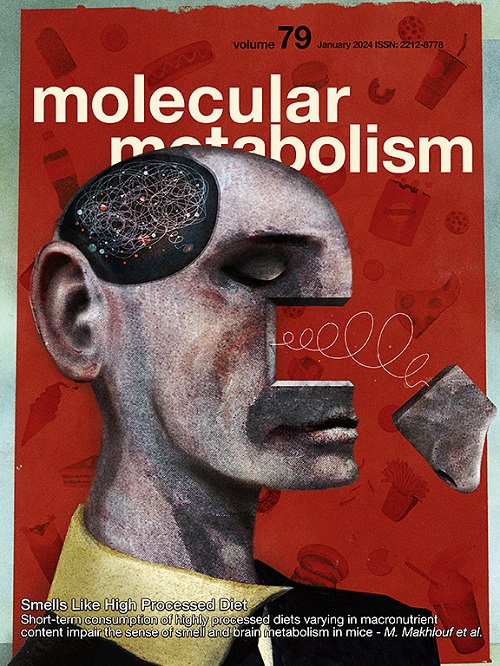SF1神经元中的JNK1调节甲状腺激素对肝脏脂质代谢的中枢作用。
IF 6.6
2区 医学
Q1 ENDOCRINOLOGY & METABOLISM
引用次数: 0
摘要
目的:下丘脑能量,如amp活化蛋白激酶(AMPK)和应激传感器,如c-Jun n -末端激酶1 (JNK1,也称为MAPK8)调节全身能量平衡。虽然AMPK在VMH的类固醇生成因子1 (SF1)神经元中的作用已被研究,但JNK1在该神经元群体中的相关性尚未得到解决。在这里,我们研究了JNK1 SF1对能量稳态的参与。方法:我们通过SF1神经元(Sf1Cre/Jnk1fl/fl)中Mapk8基因的缺失产生条件JNK1破坏小鼠。研究了完全代谢表型、禁食/再喂养和低温胁迫,以及三碘甲状腺原氨酸(T3)对棕色脂肪组织(BAT)产热和肝脏脂质代谢的中枢反应。结果:Sf1Cre/Jnk1fl/fl小鼠体重下降,葡萄糖耐量改善,肝脏脂质水平降低。然而,Sf1Cre/Jnk1fl/fl在低温暴露时不能很好地保护它们的温度。虽然在野生型(Jnk1fl/fl)和SF1Cre/Jnk1fl/fl小鼠中,集中给药T3均引起了非摄食性体重减轻,但在空白动物中,它没有促进肝脏脂质增加。结论:我们的数据首次证明了SF1神经元中的JNK1在调节肝脏脂质代谢、冷适应和中枢T3活动中是必需的。本文章由计算机程序翻译,如有差异,请以英文原文为准。
JNK1 in SF1 neurons regulates the central action of thyroid hormones on hepatic lipid metabolism
Objective
Hypothalamic energy sensors, such as AMP-activated protein kinase (AMPK), and stress sensors, such as c-Jun N-terminal kinase 1 (JNK1, also known as MAPK8) modulate whole body energy balance. While the role of AMPK in steroidogenic factor 1 (SF1) neurons of the VMH has been investigated, the relevance of JNK1 in this neuronal population has not been addressed. Here, we investigated the involvement of JNK1 SF1 on energy homeostasis.
Methods
We generated mice bearing conditional JNK1 disruption through Mapk8 gene deletion in SF1 neurons (Sf1Cre/Jnk1fl/fl). Complete metabolic phenotyping, fasting/refeeding and cold challenges, as well as the central response to triiodothyronine (T3) on brown adipose tissue (BAT) thermogenesis and hepatic lipid metabolism were carried out.
Results
Sf1Cre/Jnk1fl/fl mice displayed decreased body weight, improved glucose tolerance, and reduced hepatic lipid levels. However, Sf1Cre/Jnk1fl/fl did not properly defend their temperature upon cold exposure. While central administration of T3 elicited feeding independent weight loss in both wildtype (Jnk1fl/fl) and SF1Cre/Jnk1fl/fl mice, it did not promote hepatic lipid accretion in null animals.
Conclusions
Our data demonstrated for the first time that JNK1 in SF1 neurons is necessary for the regulation of hepatic lipid metabolism, cold adaptation and central T3 actions.
求助全文
通过发布文献求助,成功后即可免费获取论文全文。
去求助
来源期刊

Molecular Metabolism
ENDOCRINOLOGY & METABOLISM-
CiteScore
14.50
自引率
2.50%
发文量
219
审稿时长
43 days
期刊介绍:
Molecular Metabolism is a leading journal dedicated to sharing groundbreaking discoveries in the field of energy homeostasis and the underlying factors of metabolic disorders. These disorders include obesity, diabetes, cardiovascular disease, and cancer. Our journal focuses on publishing research driven by hypotheses and conducted to the highest standards, aiming to provide a mechanistic understanding of energy homeostasis-related behavior, physiology, and dysfunction.
We promote interdisciplinary science, covering a broad range of approaches from molecules to humans throughout the lifespan. Our goal is to contribute to transformative research in metabolism, which has the potential to revolutionize the field. By enabling progress in the prognosis, prevention, and ultimately the cure of metabolic disorders and their long-term complications, our journal seeks to better the future of health and well-being.
 求助内容:
求助内容: 应助结果提醒方式:
应助结果提醒方式:


